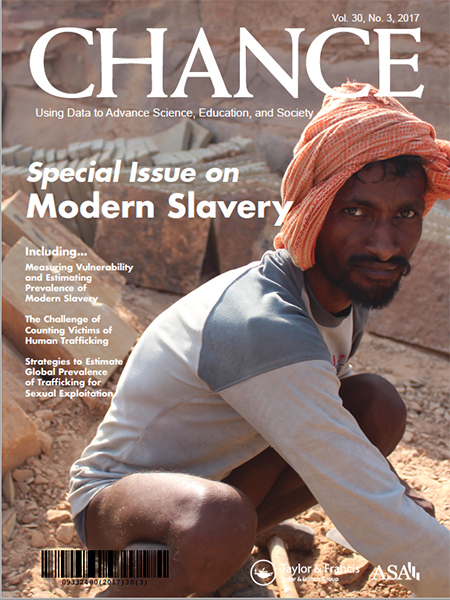CHANCE Examines Measuring the Scourge That Is Modern Slavery
“It’s much easier to protect what one can count and identify.” This simplistic, yet profound, statement succinctly summarizes the October issue of CHANCE,
which is dedicated to quantifying modern slavery.
What used to be miscalculated and often unaddressed, modern slavery is now being viewed with a much clearer lens as innovative statistical methods are giving advocates, law enforcement, and world leaders the ability to quantify it with more accuracy—developments
that likely will lead to greater public policies and outreach programs aimed at prevention and detection.
The most recent issue features commentary and analysis by some of the foremost authority figures on modern slavery, including the following:
- Kevin Bales, professor of contemporary slavery, University of Nottingham, and lead author of the Global Slavery Index
- Davina P. Durgana, senior statistician and report co-author of the Global Slavery Index, Walk Free Foundation
- Jan van Dijk, emeritus professor of victimology, International Victimology Institute of the University of Tilburg
- Paul L. Zador, senior statistician, Westat, Inc.
- Sheldon X. Zhang, professor and chair of the School of Criminology and Justice Studies, University of Massachusetts Lowell

From the historical roots of slavery to political and scientific challenges to modern-day case studies of different approaches in developed countries, this issue reflects on how far—or, in some cases, how little—society has come in its recognition
of modern slavery as a global and local concern. Articles touch on the following themes:
- Measuring vulnerability and estimating prevalence
- Estimation strategies on the prevalence of sexual exploitation
- Politics of data reporting
- Challenges of counting victims of human trafficking
And, famed statistician and author Howard Wainer takes readers on a graphical narrative of slavery through dynamic visualizations.
Modern slavery isn’t necessarily a topic discussed at the dinner table each night, but with an estimated 40.3 million people around the world enslaved in some form, it’s certainly an issue that should be prominent in society’s discourse,
and especially top of mind to government officials at all levels. Using data to advance science, education, and society, this issue of CHANCE not only demonstrates
the powerful role statistics plays in advocating for human rights and the development of public policies aimed at improving the quality of life for all, but also showcases the invaluable work of statisticians who are changing the world here and abroad.